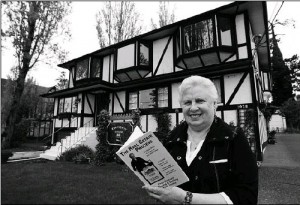Students imagine the historic Chinatown
Claudia Kwan
Sun

Vi Brown has written a book that demystifies the process of buying or selling a home, from choosing the right agent to clearing out the clutter and redecorating so that sellers can fetch a better price, to hiring a lawyer.
When, last fall, Bob Rennie formally reopened the 120-year-old Wing Sang building in Vancouver’s Chinatown, as the corporate office for his real estate companies’ and a gallery for his art, Jonah Lee-McNamee and his mom were among the guests at the Saturday evening gala.
The building, accordingly, was an easy choice when 12-year-old Jonah selected a school project for entry in the 2010 B.C. Historical Fair.
“I got interested because my mom [broadcaster Mi-Jung Lee] got invited to the opening and took me,” Jonah says. “I’m glad it was saved instead of being torn down. I like the mix of modern architecture and design with the old parts.”
He researched the building with traditional and new-age methods. He and Lee walked around the building, he taking notes, she shooting photographs. He also used Facebook to find descendants of Yip Sang, the builder and his four wives and 23 children who resided in the building.
“I interviewed (descendent) Mel Yip, who said each wife had her own floor in the six-storey building in the back, and they were exactly the same,” Jonah reports.
“Over the years hundreds of people lived there, and there were schedules for everything — going to the classroom, even going to the bathroom!”
This year, the historical fair’s Vancouver competitors participated in a workshop with students from the Emily Carr University of Art and Design.
The Emily Carr students had also taken on a Chinatown project. The artwork they created for that project is on display until the end of May in the City of Vancouver Archives in Vanier Park.
The exhibit is called Chinatown Past Present and Future and is sponsored by the city archives, ECU, the heritage fair and the Canadian Society for Asian Arts.
The ECU students’ teacher and the exhibit’s co-curator, Sheila Hall, says she wanted the students to get out and experience the sights and sounds and smells of Chinatown rather than only doing research online or in a library.
“It’s a project to connect with the community,” she says. “It’s about learning that you’re part of a city or community that exists together, and you have to investigate that in your work.”
Claire Robinson’s work is a pair of poppy-red ladies shoes atop two grey paving stones, which themselves sandwich a historical photo under a glass block.
She hopes it invokes the glass and cement sidewalk in front of the Sam Kee building. It’s the narrowest building in the world.
“I called the work Defiance because the owners had protested paying fees to the City of Vancouver,” says Robinson.
The building’s six-foot depth came from a dispute where the city expropriated land for street-widening, without compensating owner Chang Toy. He went ahead and used the remaining strip of land anyway.
The glass sidewalk covers an underground space that historically was believed to have been a tunnel for users of opium dens to escape police raids.
The site also had bathhouses, which were believed to be linked to prostitution.
In later years, there were shoe repair stands outside, as depicted in a photo dating back to 1936.
Robinson incorporated all of those possibilities in her project.
“The cement and glass are meant to look like the narrow building. The red ribbon on the shoes was tied to look like poppies, as a reference to opium,” she explains.
“The copper and steel on the heels are because of the Canadian Pacific Railway, which is why a lot of the immigrants came here from China.”
Robinson has gained a lot of respect for that cultural and historical legacy.
“The community in Chinatown has embraced everything new, without forgetting the past. They stand strong no matter what happens, while sharing their history,” she says.
Dawei Wang came to Canada from Shanghai in 2007. He knew very little about early Chinese immigrants and their experiences in B.C.
“When I immigrated, I was given a booklet from SUCCESS (an organization that helps new Canadians),” says Wang. “I had no idea Chinese Benevolent Associations had existed for so long here.”
His project, a drawing of the CBA building at 104 –108 East Pender, looks at a timeline of business activities in the building, and how the benevolent associations helped mediate conflicts and advocate for equal rights for Chinese-Canadians. For many years, the proprietors of a silk business lived upstairs.
“I want to tell people how much of a story can happen between two brick walls,” he says simply.
Hall, the instructor, seems pleased by the results.
“This is about engaging with the area, not just going down there to buy something,” she says.
“The students have begun to do that investigation, and I hope visitors [to the exhibit] can learn they can do this too.”
It’s a lesson Jonah Lee-McNamee has already learned at a young age. Now he’s waiting to see what grade he’ll get on his project.
© Copyright (c) The Vancouver Sun

